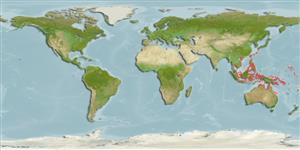>
Blenniiformes (Blennies) >
Blenniidae (Combtooth blennies) > Salariinae
Etymology: Blenniella: Diminutive of blennius, Greek,blenios = mucus (Ref. 45335).
More on author: Bleeker.
Issue
Genus Williams, pers. comm.
Environment: milieu / climate zone / kisaran kedalaman / distribution range
Ekologi
laut berasosiasi dengan karang; kisaran kedalaman 0 - 3 m (Ref. 90102). Tropical; 30°N - 30°S
Western Pacific: Ryukyu Islands southward to McClure and New Year Islands, Northern Territory, Australia.
Size / Weight / umur
Kematangan: Lm ? range ? - ? cm
Max length : 16.0 cm TL jantan/; (Ref. 48636)
deskripsi pendek
Kunci identifiaksi (pengenalan) | Morfologi | Morfometrik
Duri punggung (Keseluruhan (total)) : 12 - 14; duri punggung lunak (Keseluruhan (total)) : 19 - 22; Duri dubur: 2; Sirip dubur lunak: 18 - 22; vertebrata, bertulang belakang: 37 - 41. Diagnosis: Dorsal fin XII-XIV, 19-22, notched between spinous and segmented-ray portions; anal fin II, 18-22; pectoral rays 13-15 (usually 14); pelvic fin I, 3; caudal fin, procurrent rays 10-14, segmented rays 11-13. Vertebrae 11-12 + 26-29. Orbital cirrus simple filamentous; nasal cirri short and palmate with 2-6 branches; nape without cirri. Lateral line, continuous anterodorsally with simple pores below dorsal spines from 6-7th to 9-10th, disconnected bi-pored series posteroventrally ending below 9th dorsal spine to 1st segmented ray. Mandibular pores 5-7 Lips margin entire. Occipital crest low (up to 2.6 mm) in males, most females only have faint indication of ridge-like crest precursor except greatest specimens which may have a developed ridge up to 0.6 mm (Ref. 559, 9962). Body depth at anal-fin origin 6.8-7.3 in SL. Male body with vertical bars olive brown separated by paler interspaces, and also with dark thin horizontal stripes; also with spots near the tail; preopercular spot dark; dorsal fin spots brown, forming bands. Female with vertical dark H-shaped bars; dorsal fin spotted, caudal fin with 4-5 dark bars (Ref. 48636, 90102). Exhibits geographical color pattern variation (Ref. 9962).
Body shape (shape guide): elongated; Cross section: circular.
Adults occur in intertidal zones in large rock pools or coastal bays (Ref. 48636). Found near-shore (Ref. 9962); common in tide pools (Ref. 559). They feed on algae scraped from rubble or rock surfaces. Sometimes numerous individuals can be seen clinging to rocks out of the water when the level drops on the low of the swell. When disturbed in rock pools during low tide, they may jump out of the water to get to other rock pools or safer deeper water nearby (Ref. 48636). Oviparous. Eggs are demersal and adhesive (Ref. 205), and are attached to the substrate via a filamentous, adhesive pad or pedestal (Ref. 94114). Larvae are planktonic, often found in shallow, coastal waters (Ref. 94114).
Distinct pairing (Ref. 205).
Springer, V.G. and J.T. Williams, 1994. The Indo-West Pacific blenniid fish genus Istiblennius reappraised: a revision of Istiblennius, Blenniella, and Paralticus, new genus. Smithson. Contrib. Zool. 565:1-193. (Ref. 9962)
Status IUCN Red List (Ref. 130435: Version 2025-1)
ancaman kepada manusia
Harmless
penggunaan manusia
Perikanan: tidak ada kepentingan
Alat, peralatan
laporan khas
muat turun XML
Sumber internet
Estimates based on models
Preferred temperature (Acuan
123201): 25.4 - 29.3, mean 28.8 °C (based on 1414 cells).
Phylogenetic diversity index (Acuan
82804): PD
50 = 0.5020 [Uniqueness, from 0.5 = low to 2.0 = high].
Bayesian length-weight: a=0.00776 (0.00356 - 0.01695), b=3.00 (2.81 - 3.19), in cm total length, based on LWR estimates for this (Sub)family-body shape (Ref.
93245).
Trophic level (Acuan
69278): 2.0 ±0.1 se; based on diet studies.
Daya lenting (Acuan
120179): Tinggi, Waktu penggandaan populasi minimum kurang dari 15 bulan (Preliminary K or Fecundity.).
Fishing Vulnerability (Ref.
59153): Low vulnerability (10 of 100).
🛈
Nutrients (Ref.
124155): Calcium = 122 [59, 218] mg/100g; Iron = 0.748 [0.407, 1.330] mg/100g; Protein = 18 [17, 19] %; Omega3 = 0.065 [0.032, 0.125] g/100g; Selenium = 18.3 [8.5, 42.8] μg/100g; VitaminA = 102 [24, 432] μg/100g; Zinc = 2.37 [1.53, 3.52] mg/100g (wet weight);
